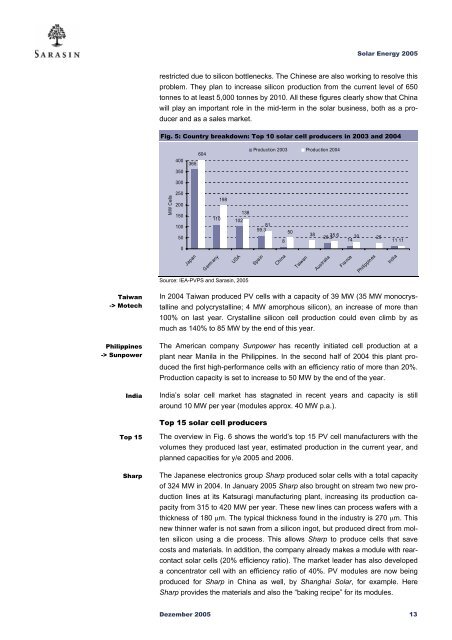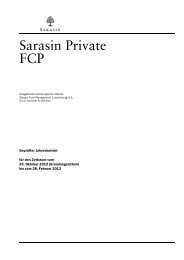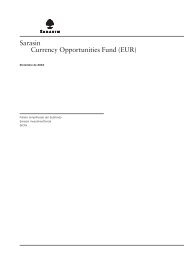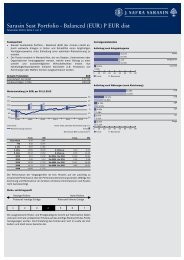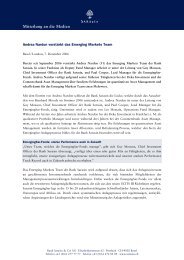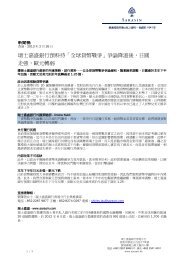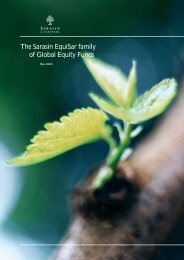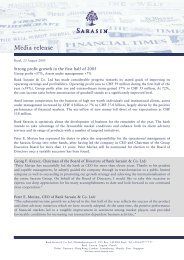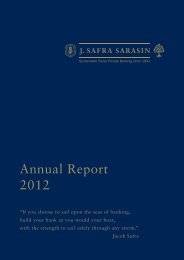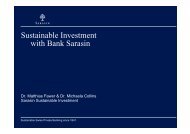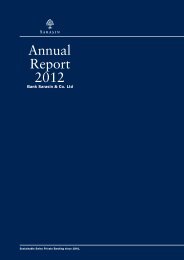Sustainability Report - Bank Sarasin-Alpen
Sustainability Report - Bank Sarasin-Alpen
Sustainability Report - Bank Sarasin-Alpen
You also want an ePaper? Increase the reach of your titles
YUMPU automatically turns print PDFs into web optimized ePapers that Google loves.
Solar Energy 2005<br />
restricted due to silicon bottlenecks. The Chinese are also working to resolve this<br />
problem. They plan to increase silicon production from the current level of 650<br />
tonnes to at least 5,000 tonnes by 2010. All these figures clearly show that China<br />
will play an important role in the mid-term in the solar business, both as a producer<br />
and as a sales market.<br />
Fig. 5: Country breakdown: Top 10 solar cell producers in 2003 and 2004<br />
400<br />
350<br />
300<br />
365<br />
604<br />
Production 2003 Production 2004<br />
MW Cells<br />
250<br />
200<br />
150<br />
100<br />
50<br />
0<br />
198<br />
138<br />
110 102<br />
81<br />
59.3<br />
50<br />
8<br />
38<br />
26.3<br />
35.6 30 25<br />
14 11 11<br />
Japan<br />
Germany<br />
USA<br />
Spain<br />
China<br />
Taiwan<br />
Australia<br />
France<br />
Philippin es<br />
India<br />
Source: IEA-PVPS and <strong>Sarasin</strong>, 2005<br />
Taiwan<br />
-> Motech<br />
Philippines<br />
-> Sunpower<br />
India<br />
In 2004 Taiwan produced PV cells with a capacity of 39 MW (35 MW monocrystalline<br />
and polycrystalline; 4 MW amorphous silicon), an increase of more than<br />
100% on last year. Crystalline silicon cell production could even climb by as<br />
much as 140% to 85 MW by the end of this year.<br />
The American company Sunpower has recently initiated cell production at a<br />
plant near Manila in the Philippines. In the second half of 2004 this plant produced<br />
the first high-performance cells with an efficiency ratio of more than 20%.<br />
Production capacity is set to increase to 50 MW by the end of the year.<br />
India’s solar cell market has stagnated in recent years and capacity is still<br />
around 10 MW per year (modules approx. 40 MW p.a.).<br />
Top 15 solar cell producers<br />
Top 15<br />
Sharp<br />
The overview in Fig. 6 shows the world’s top 15 PV cell manufacturers with the<br />
volumes they produced last year, estimated production in the current year, and<br />
planned capacities for y/e 2005 and 2006.<br />
The Japanese electronics group Sharp produced solar cells with a total capacity<br />
of 324 MW in 2004. In January 2005 Sharp also brought on stream two new production<br />
lines at its Katsuragi manufacturing plant, increasing its production capacity<br />
from 315 to 420 MW per year. These new lines can process wafers with a<br />
thickness of 180 µm. The typical thickness found in the industry is 270 µm. This<br />
new thinner wafer is not sawn from a silicon ingot, but produced direct from molten<br />
silicon using a die process. This allows Sharp to produce cells that save<br />
costs and materials. In addition, the company already makes a module with rearcontact<br />
solar cells (20% efficiency ratio). The market leader has also developed<br />
a concentrator cell with an efficiency ratio of 40%. PV modules are now being<br />
produced for Sharp in China as well, by Shanghai Solar, for example. Here<br />
Sharp provides the materials and also the “baking recipe” for its modules.<br />
Dezember 2005 13


